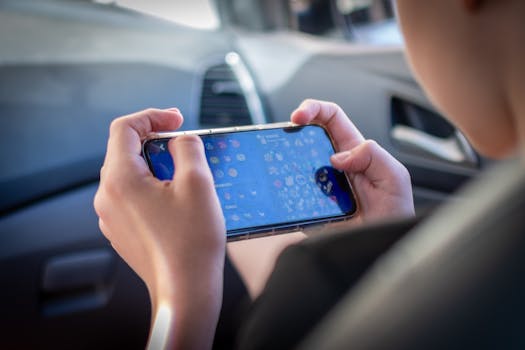You squeeze in a quick game before dinner, but your phone battery dips faster than your character’s health bar. Every player has felt that rush to save progress before power fades. Smart gaming sessions should end on your terms—not your phone’s.
The link between gaming performance and battery drain is undeniable. Every added graphic and animation demands more energy. Lower battery life can leave you frustrated, stuck to a charger, or worried about missing important calls later.
This guide offers practical, tested actions to extend your phone’s playtime. From settings tweaks to in-game habits, discover what puts you in control and see instant improvements without sacrificing the fun.
Adjust Display Settings for Maximum Power Savings
The quickest change you can make is lowering your phone’s brightness and adjusting screen settings. Phones work like flashlights—the brighter the beam, the more battery you burn.
Turning down the brightness slider, activating adaptive brightness, or reducing the refresh rate curbs energy use. Try the slider at 50 percent or less in typical indoor lighting and only go higher if clarity suffers.
Using Adaptive Brightness to Automate Efficiency
Enable adaptive brightness in the display menu. Once activated, the phone will dim or brighten the display based on your environment. You’ll rarely need to reach for the slider again.
Susan, a frequent subway gamer, switched on adaptive mode and noticed her phone still had 30 percent battery after her commute games. “I never miss a beat,” she could say.
Testing this feature for a full week will reveal if your daily routine matches its battery savings. If results don’t impress you, go back to manual adjustments for finer control.
Lowering Refresh Rate Makes a Notable Difference
Modern phones may let you set the refresh rate to 60 Hz instead of 90 or 120 Hz. A lower refresh rate can extend your battery by over an hour during gaming sessions.
Navigate to display settings and select 60 Hz. You’ll still enjoy smooth controls, especially for turn-based or puzzle games, and each round conserves energy just as efficiently.
Some players only adjust this before long trips or tournaments, reverting to higher rates when plugged in. That mini-flexibility means you stay ready for anything—without draining extra power daily.
| Setting | Where to Change | Battery Impact | Next Step |
|---|---|---|---|
| Brightness | Quick Settings | High | Keep it at 50% or less |
| Adaptive Mode | Display Menu | Medium | Turn On |
| Refresh Rate | Display Menu | Medium | Select 60 Hz for gaming |
| Color Profile | Advanced Display | Low | Switch to standard or basic |
| Night Mode | Quick Settings | Low | Enable after sunset |
Manage Game Settings for Smarter Energy Use
In-game settings shape how much strain your device endures. By optimizing these, you’ll notice an immediate impact on both visuals and longevity.
Prioritize settings like graphics quality, shadows, and frame rate. Adjust them downward within the game menu for less energy drain, especially for competitive titles or longer play sessions.
Fine-Tuning Graphics and Effects
Lowering graphics quality and disabling extra effects such as shadows or motion blur cuts the work your phone does with each scene change. Performance becomes steadier, and you’ll play that extra round without interruption.
Try a match with every setting tuned down one notch. Watch for lag or graphic hiccups. If gameplay still feels smooth, stick with these changes and check your battery at the end.
- Set graphics to “medium” instead of “high”—reducing pixel processing saves energy per minute of play.
- Turn off dynamic shadows—fewer adjustments each second mean a cooler device and a steadier charge.
- Disable motion blur for fast-paced games—a clearer picture also lets you react faster in critical moments.
- Set frame rate limits (like 30 FPS)—the difference is subtle, but battery life grows with each capped frame.
- Mute vibration feedback—every buzz draws extra power. For long sessions, rely on sound cues instead.
Finalize your preferred mix after one full session. Swapping visual splendor for longer run time keeps your phone functional beyond gaming, too.
Sound, Animations, and Their Real Power Cost
Keep sounds at a moderate volume and avoid spatial audio unless you’ll really benefit from the immersion. Every bit of processing eats precious minutes of play time.
Deactivating extra animation layers—like particle effects or menu transitions—gives your hardware breathing room. The game stays fun, but your phone isn’t fighting through constant visual noise.
- Use static menu backgrounds when available—keeps navigation snappy and extends battery life for menu-heavy games.
- Mute background music if you’re multitasking—gameplay becomes more focused, and the processor conserves energy for task-heavy actions.
- Lower sound quality to “standard” if on headphones—You’ll still hear crucial cues, but your system doesn’t overwork sound chips.
- Set notification frequency to “essential only”—less idle power burn when checking scores or updates.
- Minimize chat pop-ups during play—fewer distractions mean your phone isn’t constantly redrawing overlays.
Test which options matter most for your play style and battery meter. Changing habits here frees up energy for more rounds, not just more minutes.
Turn Off Background Apps and Smart Features
Extra apps running in the background can quietly siphon power, shrinking playtime. Swiping away unused apps isn’t just clean—it’s a battery-saving ritual to get into.
Background data transfers, location tracking, and auto-sync services continue running unless you intervene. Use system settings to control these activities before opening a game to avoid sneaky energy drains.
Stopping App Refresh and Syncs
Open the settings menu and locate the “Apps” or “App Management” section. Select unused apps and limit their background activity. On Android, a toggle labeled “Background Activity” does the trick. iPhones have “Background App Refresh” instead.
Many users forget about auto-sync toggles for mail, cloud storage, or chat apps. Turn these off with a tap before gaming and turn them back on afterward, just like flipping a light switch when leaving a room.
A player might ask, “Should I disable email sync before my big racing run tonight?” The answer: yes. With auto-sync paused, you avoid random battery dips every time your device fetches new data mid-game.
Mini-Checklist for Smart Feature Controls
To reduce distractions and improve battery efficiency:
- Toggle Bluetooth off if you’re not using wireless headphones or controllers; this prevents constant low-level radio activity.
- Deactivate GPS/location services unless your game requires it for maps or region-locked events.
- Shut off voice assistants or smart listening features—they constantly await commands, adding background strain.
- Limit live widgets or home screen feeds; they request frequent updates, causing your device to wake from idle.
Review this list every time you start a marathon session. Treat it like prepping a workspace for a focused task; the fewer distractions, the more power left for gaming.
Choose Low-Power Modes at the Right Moment
Power-saving modes are like umbrellas for unexpected rain—they shield you from a dead battery when you’re caught off guard. Activating these modes preps your device for longevity before a gaming spree or on long car rides.
Check your battery settings for options labeled “Battery Saver” or “Low Power Mode.” Enabling these limits automatic updates, background syncs, and visual effects you might not notice while playing, but you’ll definitely notice their impact on battery meter.
| Mode | Effects | When to Use |
|---|---|---|
| Standard Power-Save | Reduces all background activity, dims display | Anytime you drop below 40% |
| Ultra Power-Save | Limits apps to essentials, darkens interface | During long trips or tournaments |
| Gaming Mode | Optimizes CPU/GPU, mutes notifications | Before any extended gaming session |
Start each session by engaging the right setting. If you know the game will be intensive, preemptively turning on a game-optimized saver keeps you ahead of unexpected battery drops.
Plane Mode or No? Evaluating Network Pros and Cons
Turning on airplane mode isn’t always the go-to trick. It stops all wireless connections—great for single-player or locally saved games, but a no-go for anything that needs updates or online opponents.
If you want to maximize battery and avoid interruptions from calls or messages, toggle this before sessions where offline play is possible. For cloud saves or real-time battles, keep your Wi-Fi on and minimize background network usage.
| Scenario | Best Mode | Outcome |
|---|---|---|
| Single-Player Puzzle | Airplane Mode | Longest playtime, no distractions |
| Online Multiplayer | Wi-Fi Only | Steady connection, modest savings |
| Social Games with Chat | Wi-Fi + Notifications Off | Balanced savings, stay in touch |
Match your network setting to the nature of your game, just like choosing gear for a bike ride—you wouldn’t wear racing cleats for a stroll through the park.
Accessory Choices and Environment Tactics
Choosing between a phone case, external fan, or holding your phone freehand changes battery performance in subtle ways. Cases that trap heat can force your phone to throttle performance, while open air keeps things cooler and more efficient.
Try gaming in shaded areas or away from direct sunlight. Sunlight forces the screen to go brighter, quickly burning more battery. A shady spot or indoor space eases the strain on both your eyes and your battery reserves.
Charging accessories also have a role. Quick-charging adapters top you up fast, but regular slow chargers are gentler on your device over time. Save fast charging for emergencies, and use slow charging at night or during breaks.
Airplane trays, hard surfaces, or even a small desk fan positioned next to your device can all help dissipate excess heat. A cooler phone lasts longer, so minor changes to your gaming setup can translate to sizable battery savings.
Everyday Habits That Keep Your Battery Strong
- Charge before you’re low: Plug in at 30 to 40 percent, rather than letting the battery drain to zero. That prevents stress on your phone’s cells.
- Update games and OS: New patches may contain power optimizations and bug fixes that reduce background drain for certain titles or systems.
- Regularly restart your phone: Weekly restarts close lingering processes, granting a fresh slate and stopping rogue apps from sapping energy.
- Limit screen wake-ups: Use tap-to-wake or gentle gestures instead of pressing buttons repeatedly, which can wear down hardware and screen routines.
- Batch updates or downloads: Set aside a time slot for app updates instead of letting them occur randomly throughout the day and night.
- Enable dark mode for compatible apps: Darker themes require less light for display, especially on OLED screens, cutting energy costs per session.
Sticking with these habits increases both battery reliability and your device’s expected lifespan. A few tweaks and small changes to your routines make noticeable differences after just a few days.
Gamers who combine technical tweaks with pattern changes find the best results. Try applying one or two tips per week and track your performance in a simple note or app.
Practical Takeaways for Smarter Mobile Gaming
Review your settings before each session, like a pilot checks instruments before a flight. Proactively adjusting game and system settings lets you stay ahead of battery loss.
Experiment with one new technique per week—testing adaptive brightness, then sound management, then low-power modes—to build a customized energy-saving playbook tailored to your own habits and favorite titles.
Remember, keeping your phone cool and background-free isn’t just about in-game performance. It means longer device lifespan, fewer interruptions, and less frustration from sudden power cuts while you’re close to victory.
Stay flexible—no single trick fits every game or every device, so keep exploring new options and tweaking routines. Your battery, wallet, and game library will thank you.

